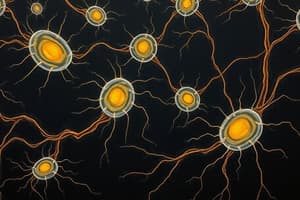Podcast
Questions and Answers
What function do guard cells mainly serve in plants?
What function do guard cells mainly serve in plants?
- Produce food through photosynthesis
- Transport nutrients from roots
- Absorb water and minerals
- Regulate rate of transpiration (correct)
Which adaptation allows root hair cells to effectively absorb water and minerals?
Which adaptation allows root hair cells to effectively absorb water and minerals?
- Has a large surface area due to its long and thin structure (correct)
- Equipped with numerous chloroplasts
- Contains lignin
- Forms a continuous tube
What type of modification is classified as apical in nature?
What type of modification is classified as apical in nature?
- Microvilli (correct)
- Tight junctions
- Hemidesmosomes
- Desmosomes
What is the primary role of cilia?
What is the primary role of cilia?
What is a characteristic feature of xylem vessels?
What is a characteristic feature of xylem vessels?
Flashcards are hidden until you start studying
Study Notes
Specialized Cells in Plants
- Guard Cells: Control transpiration by regulating stomatal openings; possess cell walls of varying thickness for flexibility.
- Root Hair Cells: Maximize absorption of water and minerals from soil with elongated, thin structure and large surface area.
- Photosynthetic Cells: Conduct photosynthesis to produce food; characterized by a high number of chloroplasts for efficient light capture.
- Xylem Vessels: Facilitate water and mineral transport from roots upwards; contain lignin for structural support and lack protoplasm, creating a continuous flow.
Cell Modifications
- Adaptations acquired post cell division enhance functionality and efficiency.
Types of Cell Modifications
- Apical Modifications: Enhance absorption, secretion, or movement; examples include microvilli (increase surface area) and cilia (aid in movement).
- Basal Modifications: Improve attachment and transport within tissues; features include hemidesmosomes and basal infoldings for stability.
- Lateral Modifications: Promote cell adhesion and intercellular communication; include tight junctions, desmosomes, and gap junctions for structural integrity and signaling.
Cilia
- Hair-like organelles extending from cell surfaces, involved in movement or sensation.
- Two types:
- Non-motile Cilia: Serve primarily as sensory receptors.
- Motile Cilia: Assist in locomotion by creating movement.
Flagella
- Long, whip-like structures composed of protein filaments; crucial for motility in various cells.
Villi or Microvilli
- Tiny, finger-like projections that increase surface area for absorption, playing a key role in nutrient uptake.
Pseudopods
- Temporary cytoplasmic extensions known as "false feet"; facilitate movement and the ingestion process in certain cells.
Studying That Suits You
Use AI to generate personalized quizzes and flashcards to suit your learning preferences.



